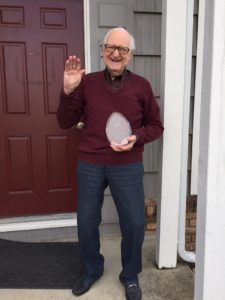EVERYDAY HUMANIST HERO | Art Jackson

TheHumanist.com’s series Everyday Humanist Heroes celebrates our movement’s group organizers, activists, support staff, and volunteers making a difference in their communities. Who do you want to celebrate?
When it comes to humanist group organizing toward making a difference, Arthur M. Jackson has been doing it longer than anyone. It all started in the early 1960s when he attended the American Humanist Association’s (AHA) first training session for humanist celebrants, held at AHA headquarters, then in Yellow Springs, Ohio. He subsequently, on August 3, 1965, became the first person to be certified by the AHA to perform weddings and other ceremonies.
From 1965 to 1969 he served as assistant executive director of the AHA under Toby McCarroll, first in Yellow Springs and then in San Francisco, California, when the AHA moved its offices there. In this capacity he set up and then administered the Division of Humanist Counseling as the AHA’s celebrant training and certification arm.
In 1969 he relocated to San Jose to serve as the full-time, paid executive director of the Humanist Community of San Jose, an AHA chapter (now the Humanist Community in Silicon Valley). His aim was to experiment with developing a model that would help chapters become more firmly based, later detailed in his self-published book, The Humanist Chapter of the Future and the Future of Humanism (1993).
Jackson’s chapter programming soon became among the most unique in the movement. On more than one occasion a public Humanist Renaissance Festival was held to raise funds and celebrate humanism’s historic connection with that era. Prison chapters were developed at San Luis Obispo and Vacaville, one of the incarcerated members of which was Civil Rights activist Maulana Karenga, creator of Kwanzaa. The San Jose chapter’s main meeting developed from a monthly event into a weekly Sunday morning gathering that eventually became equal in size and scope to that of a small church.
I first met Art in 1977 when attending the AHA national conference in Los Angeles in my capacity as a chapter leader from San Diego. Then in 1979 I visited him at his home in pursuit of advice on how best to organize AHA chapters on the West Coast, taking advantage of the breadth of his experience. In 1981, when I was AHA national administrator, I attended one of the humanist celebrant summer conferences that Art put on annually in Los Gatos (near San Jose), becoming a celebrant myself. By that time Art was again director of the Division of Humanist Counseling, a position he held until 1991 when management of that division was transferred to the AHA national office—then located in Amherst (Buffalo), New York—and the whole division was merged into the Humanist Society, which provided a separate corporate umbrella for the celebrant program.
Meanwhile, Art continued to grow his chapter in San Jose as an important part of the AHA network, securing its recognition as Chapter of the Year in 1993. His chapter also hosted AHA national conferences in 1989 and 2010. In his individual capacity, Art served as a member of the AHA board of directors for a number of years.
Then in 2008 he joined the Humanist Society board, serving as secretary/treasurer starting in 2011. He retired from the board in 2022.
Therefore, given his extensive dedication to the humanist cause, both at the national and local levels, it seemed only natural to formally recognize the significance of his work. So, this past December, the Humanist Society honored Art at his home with its Lifetime Achievement Award, a glass flame sculpture, conferred “with gratitude and appreciation for your many decades of service.”
